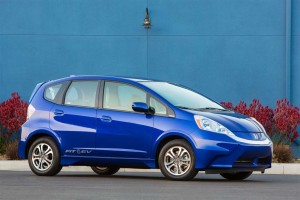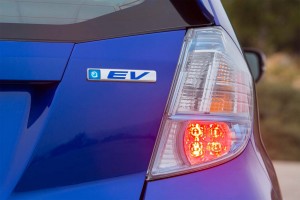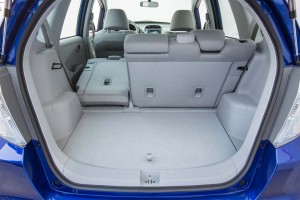Driving the 2013 Honda Fit EV even a couple of hundred meters easily disproves the mindless chatter, heard in some quarters, about electric vehicles being nothing more than gloried golf carts.
In fact, the light, nimble Fit EV, which is a pure battery-electric vehicle with no gasoline motor tucked away onboard for support, is a blast to drive. It’s well-balanced, handles nicely and incorporates new technology that neutralizes the relatively harsh and unnatural brake feel common in hybrids and EVs equipped with regenerative braking.
In addition, the Fit EV, which also has an independent rears suspension as well as the new brake set, outperformed the Nissan Leaf, its nearest competitor, on a small handling course that Honda set up during a first drive of its battery subcompact. The Fit EV also is equipped with three different driving modes, sport, normal and Eco, which can be reached by pushing the appropriate button.
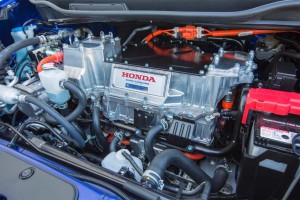
The new version of the Fit features a pure battery-electric drivetrain powered by lithium-ion batteries.
The brand new regenerative braking system in the Fit EV also helps recharge the lithium-ion battery pack while slowing the vehicle on a downhill descent turning energy into electrical power without the driver having to push down on the brake pedal. Even without pushing down on the brake pedal, the system will slow the car enough to prevent a headlong descent. The system, which is another clever piece of engineering from Honda, also manages to regenerate as much as 8% more energy for the battery than comparable system used by other automakers.
The regenerative braking system is partly responsible for the battery car’s eye-catching fuel economy. It helps propel the 2013 Honda Fit EV to an eye-catching 132 MPGe – or miles per gallon equivalent — in city driving and 105 mpg in highway driving. The combined figure comes out to 118 MPGe, according to the Environmental Protection Agency, which makes the battery version of the Fit the most fuel-efficient vehicle in America.
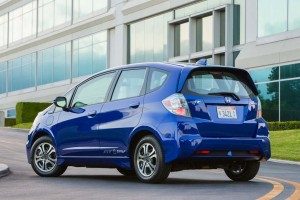
Visual changes to the conventional, gas-powered Honda Fit are modest and meant to improve aerodynamics -- which translates into more range.
The Fit EV is not only efficient, it’s also quick. The powertrain can produce 189 foot pounds of torque, which is substantially more than 105 foot pounds of torque in the conventional five-passenger subcompact equipped with an internal combustion engine. Fit EV’s electric motor produce 123 horsepower.
Consequently, the Fit can get up to speed quickly, seemingly going from zero to 40 in no time at all. Of course, battery cars tend to be engineered for urban-style driving, so acceleration begins to peter out at that point. But there’s enough juice to inspire reasonable confidence merging onto the freeway. The Fit EV’s top speed is 90 miles per hour – enough to do a comfortable pass — but it seemed as it if could also go a bit faster if pushed.
But freeway driving is hardly the Fit’s best attribute because of the current limitations in battery technology. The battery, which comes from Toshiba, can be recharged in as little as three hours using a 240-volt circuit — and is designed for long-life, according to Honda.
But the fully-charged range of the Fit EV is just 82 miles. That’s enough for a typical commute in most U.S. cities but hardly the kind of battery pack required for running hard out on the freeway or for a long drive on canyon and mountain roads.
Unlike rival Nissan, which developed an entirely new platform and body for its Leaf battery-car, Honda took a more expedient route, adding some minor body modifications — primarily to improve range-enhancing aerodynamics — to the stock Fit subcompact.
Honda is trying to neutralize some of the range anxiety with a full-suite of phone apps that keep track of the state of charge, show your available range and help find the closest public charging stations should you need to top off before heading home.
Nonetheless, pure battery-electric vehicles such as the Honda Fit EV still have range limitations that will curb their appeal for many drivers. That appears to be one of the main reasons Honda plans to initially roll out the new model in only a few select U.S. markets. Honda’s initial marketing effort this summer will be limited to California and Oregon – but the maker will add a number of East Coast markets early next year.
The maker hopes to offset the limits of battery technology by outfitting the Fit EV with a full range of features such as automatic climate control, heated seats, power windows and door locks and the Honda Satellite Linked Navigation System.
Since the market for EVs is still only emerging, Honda only expects to sell or, more accurately, lease 1,100 over the next couple of years. The 2013 Fit EV’s three-year lease price of $389 a month computes to a Manufacturer’s Suggested Retail Price of $36,625.
The price, however, doesn’t include the cost of the 240-volt at-home charger. Considering the much longer, 15-hour charge times on standard 110-volt power it should be considered a necessity by anyone considering a 2013 Honda Fit EV (or any other battery car, for that matter). The charging unit and the estimated cost of having it installed in Southern California is about $1,500 dollars.
Considering the limited volumes Honda plans some might dismiss the 2013 Fit EV as a meaningless exercise. Indeed, one might question whether the maker would have bothered if it didn’t have to comply with so-called Zero-Emission Vehicle, or ZEV, mandates enacted by California and a handful of other states. But to our pleasant surprise the Honda Fit EV shows that battery cars can deliver a reasonably enjoyable driving experience.

